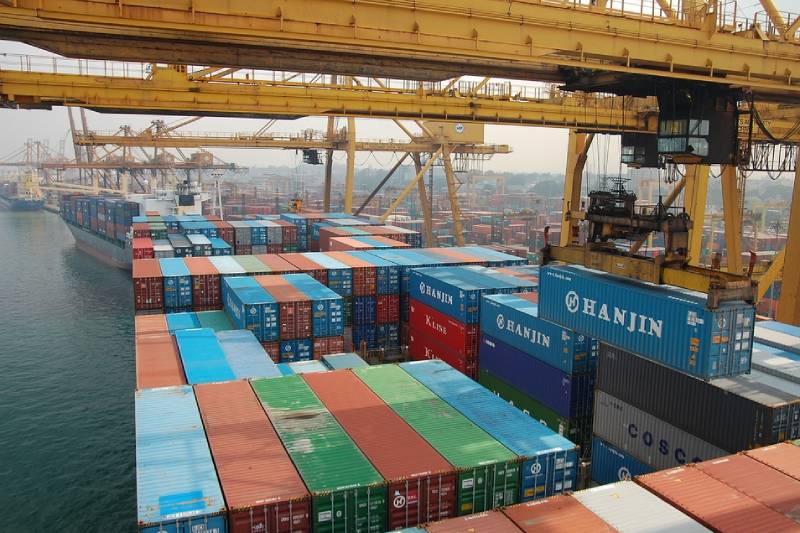Jan. trade deficit at $ 730 m, up from $ 617 m
Merchandise exports down 3.7% as all sectors see decline
Food and vehicles push imports up by 4.8% to $ 1.7 b
Sri Lanka has begun 2020 with a wider trade deficit of $ 730 million, up by over $ 100 million year-on-year, as merchandise exports declined by 3.2% in January, earning just over $ 1 billion, and imports rose by 4.8% to $ 1.7 billion.
Terms of trade, i.e., ratio of the price of exports to the price of imports, deteriorated by 3.7% (year-on-year) in January 2020, as export prices declined at a faster pace than import prices.
The Central Bank said yesterday continuing the year-on-year declining trend observed since July 2019, earnings from merchandise exports declined by 3.2% to $ 1,005 million in January 2020, with all major export sectors recording declines in comparison to January 2019. Earnings from agricultural exports declined in January 2020 (year-on-year) driven by all of its sub sectors except for minor agricultural products. Earnings from tea exports declined due to the combined effect of lower export volumes and average export prices.
In addition, earnings from spices declined in January 2020, mainly due to lower export volumes of many sub categories, while export prices also declined except for nutmeg and mace. Earnings from seafood exports declined with lower demand from the USA.
Meanwhile, earnings from coconut exports declined, mainly due to lower export earnings from desiccated coconut categorised under kernel products and fibre under non-kernel products. In contrast, earnings from export of minor agricultural products increased during the month, mainly led by exports of arecanuts and betel leaves.
Earnings from industrial exports declined in January 2020 in comparison with January 2019, with low earnings from almost all sub sectors, except petroleum products, chemical products and gems, diamond and jewellery.
Earnings from food, beverages and tobacco exports declined, led by manufactured tobacco exports and miscellaneous food preparations. In addition, earnings from rubber products, declined mainly driven by lower tyre exports.
Earnings from textiles and garments declined marginally, as a result of lower earnings from the USA and non-traditional markets such as India, South Korea and Mexico, despite an increase recorded in exports to the EU.
Further, earnings from machinery and mechanical appliances declined with lower exports in all subcategories. Conversely, export earnings from petroleum products increased substantially, due to higher earnings from bunker and aviation fuel exports resulting from higher bunker quantities and prices as well as higher earnings from naphtha exports.
Earnings from mineral exports recorded a decline in January 2020, year-on-year, with weaker performance in all subcategories.
The export volume index in January 2020 improved by 2.9% (year-on-year), while the export unit value index declined by 6%, indicating that the decline in exports was driven entirely by lower prices when compared to January 2019.
Expenditure on Merchandise imports increased, on a year-on-year basis, in January 2020 for the second consecutive month, by 4.8% to $ 1,735 million, driven by higher consumer and investment goods imports.
Expenditure on consumer goods imports increased in January 2020 with the increase in expenditure on both food and beverages and non-food consumer goods imports. Accordingly, vegetables (mainly big onions), dairy products (mainly milk powder), sugar and spices (mainly chillies) imports, categorised under food and beverages, increased.
Meanwhile, under non-food consumer goods category, expenditure on personal motor vehicle imports recorded growth, on a year-on-year basis, for the second consecutive month in January 2020. However, expenditure on personal vehicle imports declined significantly when compared with December 2019. In contrast, expenditure on beverages (mainly alcoholic beverages) and seafood (mainly canned fish) imports declined, in comparison to January 2019.
Meanwhile, expenditure on investment goods imports increased in January 2020 due to higher imports of machinery and equipment and transport equipment. The increase in expenditure on machinery and equipment imports was mainly driven by turbines, telecommunication devices and electrical machinery and equipment.
Meanwhile, expenditure on transport equipment increased with higher expenditure incurred on railway equipment such as locomotive engines and carriages, and lorries. However, expenditure on building material imports decreased mainly due to low expenditure on iron and steel and those articles imports such as iron bars and rods although higher outlays on the importation of the bridges and bridge sections continued to increase in January 2020.
Expenditure on imports of intermediate goods declined in January 2020, mainly due to lower expenditure on fuel, owing to lower import volumes of all subcategories namely crude oil, refined petroleum and coal, although average import prices of crude oil and refined petroleum increased, when compared with January 2019.
In addition, expenditure on base metals (mainly iron and steel), wheat and mineral products (mainly cement clinker) imports declined in January 2020. However, import expenditure on textiles and textile articles increased, led by higher expenditure on fabric and fibre imports.
The import volume index increased by 7.3%, while the unit value index declined by 2.3% in January 2020, indicating that the increase in imports was driven entirely by higher volumes when compared to January 2019.
(FT)

